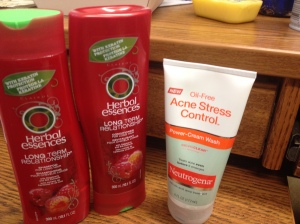I wash my hair almost every day, sometimes every other day, but it’s marching band season, and it’s hot. There is no way I can get around showering every day right now and still smell and feel clean. I almost always use Herbal Essences usually the kind pictured below. I like how it smells and I’ve used it since I first started buying my own hair stuff instead of stealing my mom’s. I also use Neutrogena face wash sometimes the cream wash and sometimes the scrub kind even though I know the scrub is made out of bits of plastic too small to be filtered out in the wastewater treatment plant. Not that either of these two face washes helps my face feel better, but it appeases my mother that I’m doing something about acne. At least I’m not using a facewash that leaves my face feeling like a layer of skin has been chemically burned away. My skin is sensitive, dries out fast, and is basically always unhappy for one reason or another but especially in the winter.
Here’s some data about how much shampoo, conditioner, and face wash I use:
- About a tablespoon of shampoo and conditioner each
- About a tablespoon of facewash
These are the items I have decided need to go.
Wow I’m glad I did. Even at the end of this I sure am not going to be going back to Herbal Essences no matter how much I like the smell. Tests found that this shampoo in particular contained such a high level of the carcinogen 1,4-dioxane that it needs warning labels in California.
A case study done in Germany follows a bottle of Henkel Ag & Co. shampoo from raw materials through disposal including the carbon and water costs of actually using the shampoo and treating the water in the end. In total, the process creates 290 grams of CO2 per hair wash. Multiply this times two and expand out to the whole semester of fifteen weeks I would normally have used it assuming showering every day. That is 30,450 grams per semester. A plastic water bottle is generally worth 2-7 times the amount of the water contained, 16.9 fl. oz.
Herbal Essences is also guilty of using palm oil in their products. So is Neutrogena. Two strikes. Palm oil is a highly unsustainable product found in just about everything being sold in the US. Representatives from Greenpeace say that the worst contribution of deforestation to global warming comes from the chopping down of tropical rain forests fueled by a demand for the new crop of palm oil especially in Indonesia. Indonesia might not seem like a big deal in terms of global warming, but Indonesia ranks third on greenhouse gas emitters in large part because of the slash and burn of rainforests. This is also causing the extinction of our closest genetic relative: the orangutan.
Neutrogena has sought to curb this and are members of the Roundtable on Sustainable Palm Oil.
These are my targets for this semester, and I’ll be documenting how well using natural and local shampoo, conditioner and facewash work as well as my new footprint.
http://www.greenbiz.com/news/2010/03/12/p-g-reformulating-herbal-essences-limit-toxins
http://www.npr.org/templates/story/story.php?storyId=90714122
Click to access pcf_henkel_shampoo.pdf
http://www.goodguide.com/products/336895-neutrogena-oil-free-acne


Wow. I did not know that about Herbal Essences!